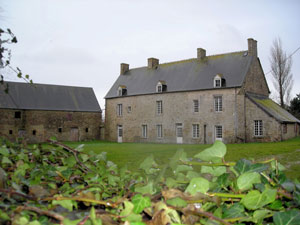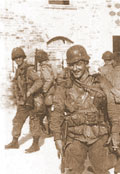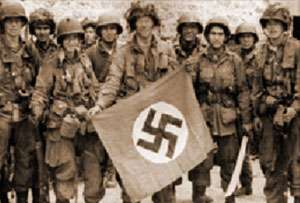Beuzeville-au-Plain
Ravenoville

James Flanagan Interviewed by James D. Sutton
Marmion Farm
The very first newsreel of the airborne invasion in Normandy shown in movie theatres in the United States was filmed at this particular farmhouse. Some of the photos show Stopka's task force displaying the first Nazi flag captured by the 101st Airborne Division.
Many famous photographs in D-Day and WWII books were taken at this site, where troopers gathered after they landed in Normandy.
Private Guth interviewed
At 0110, June 6, 1944, Pfc Forrest «Goody» L. Guth hit the silk over Normandy. The best «Easy Company» could pull together after the jump was around a dozen men - our Coy, 1st Lt. T. Meehan III, O-437484, and most of Hq personnel never reported to the assembly area and were not seen again (Aircraft #66 was hit by flak and crashed, killing all its 21 occupants)! I landed in a cow pasture, about 3 miles off target, somewhere between Ravenoville and the beach, and around dawn ran into more men from my stick. After trying to figure out what to do, we started moving toward Ravenoville searching for the rest of «Easy». At the southern edge of the village stood a «square» farmhouse used by the Germans (Marmion Farm), the four of us, together with stragglers from different outfits and under leadership of Major John P. Stopka, 3d Bn, 502d PIR (KIA in the Bulge Jan 14, 1945), captured the stronghold - that's the place where the 101st Airborne displayed the first nazi flag captured by our Division! Just hours after the D-Day invasion began, James Flanagan, center, with other paratroopers of the 101st Airborne Division, captured a Nazi flag from a command post headquarters in a farm complex near Ravenoville. The paratroopers had landed in the middle of the night to eliminate German resistance along the causeways to Utah Beach (National Archives).
James Flanagan parachuted into Normandy hours before the U.S. Army's 4th Infantry Division was to land at Utah Beach on June 6, 1944. He and his fellow airborne soldiers came down in the middle of the night, charged with removing any German resistance along the vulnerable causeways that led inland from the beach. They would be the prelude to the largest amphibious invasion in history.

Forrest Guth, is clowning around here with a Nazi helmet on June 7th.

After landing near Ravenoville, France, the first vehicle that the paratrooper saw later in the morning while mopping up near a captured farm complex was coming from the beach and carrying two men, one an International News Service photographer. It was 9 a.m., about three hours into «the longest day» in history. The soldiers took a brief timeout so that the photographer could record the event. Flanagan, in the center, smiled while clutching the Nazi flag that had been «liberated» from the enemy command post headquarters in the farm complex they now occupied. When this picture was wired back to the States, it became one of the most widely distributed newspaper photos taken from the events of June 6.
WWII: Once on the ground, how did you proceed?
Flanagan: Using my clicker [cricket], I started looking for company. At first I didn't recognize my position from the maps that I had previously studied. I heard some shooting, so I began moving toward Ravenoville. The firing was coming from a German MG42 machine gun. The person pulling the trigger, however, wasn't a very good shot. The Army had trained me how to crawl so that I was only 4 inches off the ground, so I did. Soon there was more activity. I began recognizing the sounds of our M-1s. By way of moonlight, using my clicker, I began joining up with troops from other companies and regiments. By dawn, there were about 20 of us. We didn't know each other, but a major [Major John P. Stopka, 3/502nd] came over and organized us into a group and led us on an attack of a German garrison at a farm complex [Marmion] at Ravenoville. This was also the location of the German MG42 that had been firing on us. The Germans were about platoon size in strength. The battle lasted for about an hour and a half. Once the farm complex was captured, the major had us running patrols around the outlying areas in order to keep the Germans from sneaking up on us. We maintained outposts and patrols until we were relieved later in the day. We also had a dozen prisoners who we had to contend with. By noon, the 4th Infantry Division had arrived from Utah Beach, and we were relieved. I spent the night of June 6 at Ravenoville. By June 7, I was back with my regiment and company, where I was assigned to patrols in and around the 502nd's areas of responsibility in Normandy near Houseville. We would patrol the area and try to clean out remaining German defenders. We ran around the bush. They ambushed us, and we ambushed them. This went on for several days.